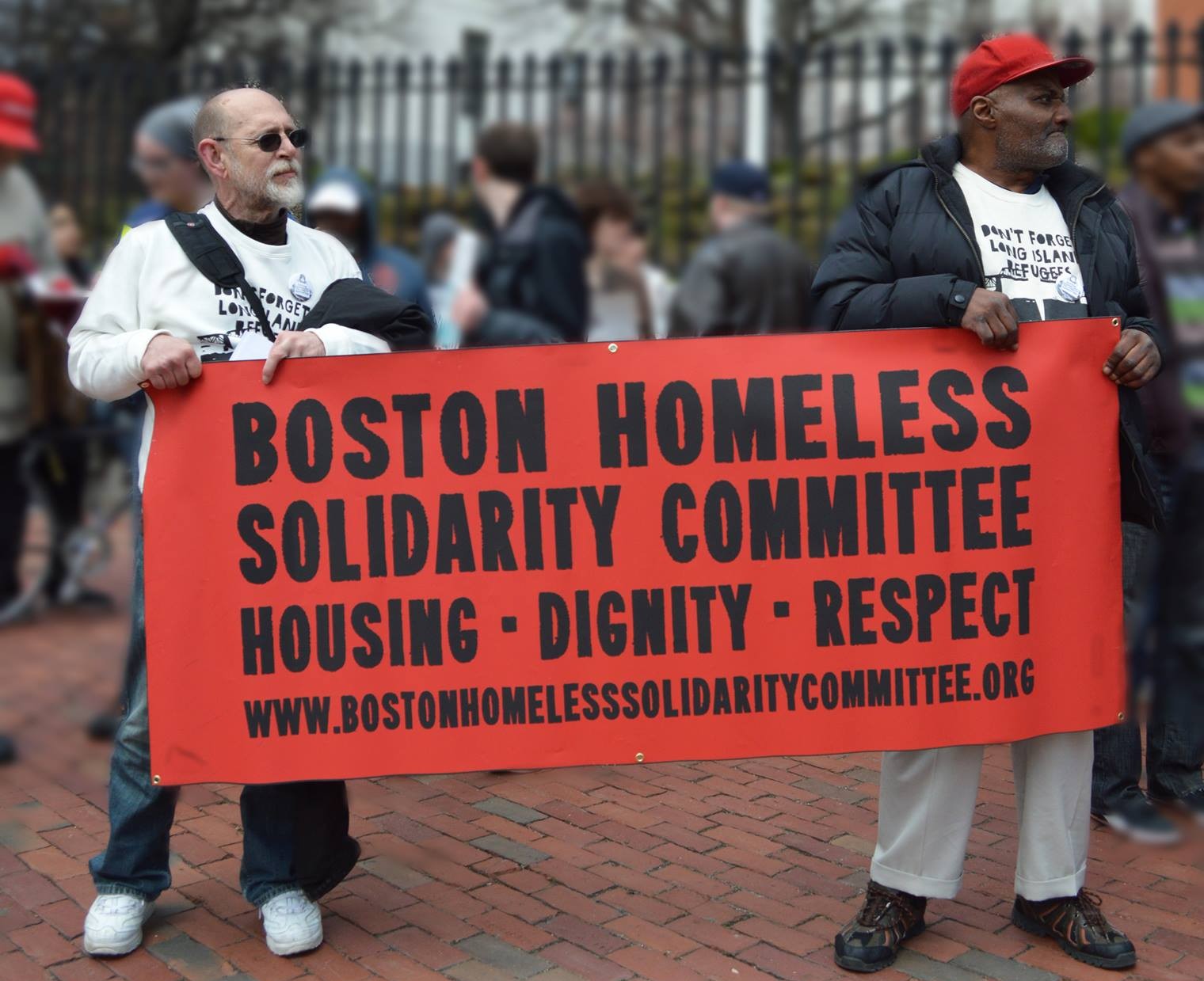Advocates marched and rallied on Thursday, April 23 to call for the state to replace the beds and programs that were lost after the city closed the Long Island shelter and detox unit last October. They say that the city has not done enough to help displaced homeless people and recovering addicts.
“We’re here to get the state to turn the heat up on the city,” says Cleve Rae, a spokesperson for the Boston Homeless Solidarity Committee. The Long Island campus was home to the city’s largest homeless shelter, several recovery and transition programs and a privately-owned 60 bed detox center. However, the city closed the only bridge that provided access to the island with only four hours of warning after deciding it was unsafe for continued use—a years-old complaint.
With no bridge and no support for ferry services (the city claimed it would be unsafe to travel in winter waters), the city lost access to 450 emergency shelter beds and 250 recovery beds. Some programs, like Safe Harbor, relocated to other shelters, but others still haven’t been replaced. The city set up 250 cots and mats at the South End Fitness Center and opened up 100 beds in the new Southampton Shelter in January. However, the shelter is an old building and not completely renovated, so the city delayed plans to open up another 300 beds after discovering asbestos and faulty wiring in the rest of the structure.
For this march, the Boston Homeless Solidarity Committee emphasizes the loss of recovery and treatment beds. The city opened a 75 bed facility in Mattapan, providing transitional services for 45 recovering addicts and reentry services for 30 ex-convicts, but so far, nothing else has been replaced. Rae, a homeless man and former client of both Long Island shelter and South End Fitness Center, calls the loss of treatment “the worst part of the Long Island closing.”
About 50 people came out for the march, which started at Woods-Mullen and ended at the state house, stopping at shelters along the way. The group delivered a letter to the office of Marylou Sudders, the secretary of the Executive Office of Health and Human Services.
The letter calls for the state to “take the lead” and re-open treatment facilities on Long Island. The activists argue that clients can be transported on ferries and reference philanthropist Jack Connors’ offer to repair the island’s piers. For the record, Connors funds a summer camp called Camp Harbor View that uses part of the island.
City officials rejected the idea of using ferries back in October, citing the poor condition of the piers, the turbulent winter waters and concerns about medical emergencies (no bridge means no ambulances, though advocates note that ambulance boats could be an option). The Boston Homeless Solidarity Committee suggests that the campus could and should be used in the summer, now that the waters are calmer. The Committee also requests that the state form a working group to handle the process.
Gov. Charlie Baker vowed earlier this year to tackle the state’s opioid addiction problem. Baker’s predecessor, Deval Patrick, actually declared the so-called “opiate epidemic” a public health emergency. However, there has been no state assistance in the wake of Long Island’s closing, not even in restoring treatment programs. One speaker emphasizes the need for recovery and detox beds, saying Andrew House saved her life. A local medical student—a member of Boston Medical Students for Long Island—also worry about where to send their future patients. The Boston Homeless Solidarity Committee believes those beds would have prevented overdose deaths over the last six months. There are no hard numbers on overdose deaths in Boston—state police don’t record such deaths in Boston, Springfield and Worcester—but the city did see an increase in overdose deaths last December: a total of 32 in that month alone.
During the march and rally, Committee members highlight other issues. For example, Cherai Mills addresses the homeless youth crisis, both at the rally and during a stop in front of Bridge Over Troubled Water. The non-profit organization offers the only youth shelter, for those aged 14 to 24, in Boston, but it only has 12 beds. Mills has stayed there herself and while she says the workers are great, “more help is needed … even Bridge has trouble housing youth.” Mills also cites rising rents, low-employment opportunities and disruptive shelter life (which makes it hard to be a refreshed, alert worker) as other challenges facing youth.
Marchers also call for the state to adopt a housing-first model, with one speaker, a local med student, citing Utah’s successful housing-first model. Utah found that giving the homeless homes rather than simply shelter beds cost the state half as much money. At an impromptu meeting two weeks ago, Felix Arroyo, Boston’s chief of health and human services, revealed that Boston was looking at Houston’s housing-first model for ideas.
While recovery and treatment were the focus of the rally, the speakers emphasized that factors like the economy, housing, health and many others are related to the current crisis. As one medical student said to the crowd, “We’re trained to treat not just the symptom but the cause. For many of our patients, the cause is poverty.”
Six months since the closing of Long Island, the state, should it actually get involved, will need to treat much more than the symptoms.

Leave a Reply
You must be logged in to post a comment.